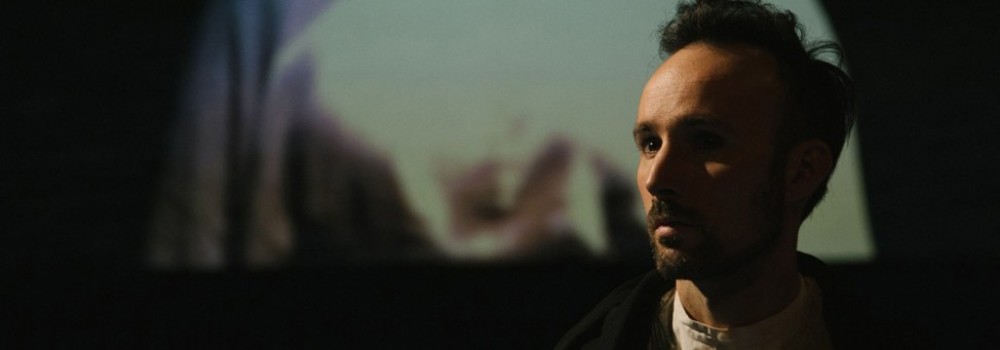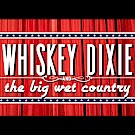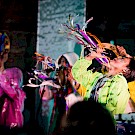On a hot Saturday night at the aptly chosen Imago Theatre, we ushered into a small room lined with comfy chairs, most of them plastered with RESERVED signs. People fanned themselves with the text-heavy program, filling the rafters for the second of two shows on August 16. After a test run of the songs last November with FearNoMusic at the Alberta Rose Theatre, we were here waiting for Holcombe Waller to reveal the final metamorphosis—the full-staged theatrical premiere of Wayfinders.
“What does imago mean?” the man in front of me mused aloud to his lady friend. “It’s Latin for image, right?”
Having a love of bugs and things with wings, I inserted myself and offered that it’s also the name for a newly emerged adult butterfly or cicada. In zoology, the imago is the last stage of an insect’s metamorphosis. While it is growing and developing, it also is called the imaginal stage. The plural of imago is imagines, which also happens to be the name for the Roman funeral masks of noble ancestors displayed in homes and worn by actors who were professional mourners during the procession. In Jungian psychology, imago is used to describe the idealized image of another person and the way that people form their personality by identifying with the collective unconscious. Jung later replaced the term imago with archetype.
So, why the entomology, etymology and history lesson? Because the topics of psychology, personal image, navigation, life and death have an oddly synchronous bearing on Waller’s latest science fiction-themed, imaginal song cycle, Wayfinders.
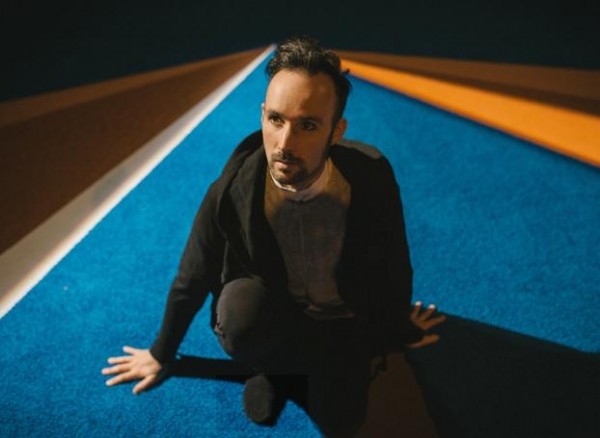 Holcombe Waller posing on the carpeted deck of his spaceship: Photo by Tyler Kalberg
Holcombe Waller posing on the carpeted deck of his spaceship: Photo by Tyler KalbergThe scene is set on a spacecraft in the distant future, but there’s no Starship Bridge onstage or captain's chairs to call out navigation commands from. Instead, there's just an orange and blue carpeted compass of sorts, like a half sundial or sail canvas in that classic, color contrast trope for sci-fi futuristic stories. Here, the pattern and colors evoke the oppositions of land and sea, day and night, time and space—and are very much reminiscent of The Fifth Element. Behind this, a half-moon arc of dolly track where a “surveillance rig” camera moves about and projects images of the passengers (or performers) on a screen behind them.
Similarly, the ship itself is more concept than construct. It is a transhuman “mindspace” of projections, where five passengers experience a collective consciousness controlled by the autonavigator. Take a minute if you need to unpack that—or let me offer an analogy. Imagine if Facebook or Twitter were a spaceship with a stream of consciousness feed of all humans, linked together and constantly scanning, cataloguing, saving, uploading and installing all of our lives into the body of the ship and the vast, virtual data store that is our world.
Or as the opening text of Wayfinders suggests, we are a disembodied intelligence made up of “identity records,” without “all that sloppy flesh attached.” Now, imagine if we had to hear and experience the incessant broadcast and mind chatter of our fellow travelers with their “swarms of memes fluttering everywhere, binding to all the energy centers in your subconscious and fluffing them up into their fullest archetypical expressions.”
Oh wait… never mind, we’re already there—it’s called the internet!
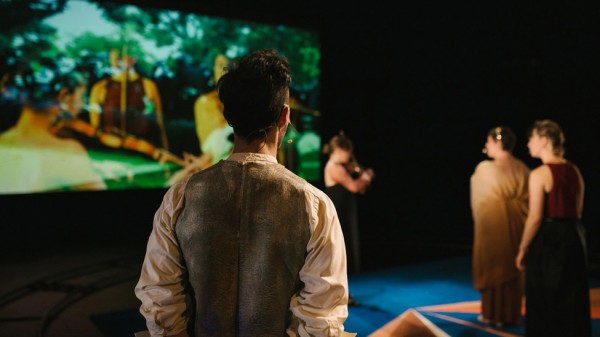 Waller, the AI autonavigator: Photo by Tyler Kalberg
Waller, the AI autonavigator: Photo by Tyler KalbergFor this musical theater experience, Waller—the offstage AI autonavigator—wryly observes that we’ve “gone way beyond cute cat videos.” And this is one of the many passages along the way that make Wayfinders such a strange, sad, savvy and self-reflexive critique. On display here too is Waller’s full interdisciplinary repertoire with integration of music, video and theater design.
Two of the passengers are deceased and float about as narrators and singers—a Greek chorus for this tragic romance comprised of Waller (writer, director, producer and singer) and Alexandra Deahl (vocals and bass). The other passengers are physically alive and playing music, including Ben Landsverk (music director, viola, bass and keyboards), Ellen McSweeney (violin), Elise Batchford (flute), and Leander Star (French horn).
Waller’s voice lilts and radiates through techno arias of scintillating vocoder harmonies. Deahl’s feathered voice glides and nestles in, dovetailing peacefully and complimentary to Waller. The styles range from R&B-tinged electronica to classical opera, from liturgical and hymnal to anthems like “Roll On Country Roll On,” choraling the themes of nationalism, technology and evolution—a song that would fit nicely in say, a dystopian version of Les Misérables. There are these subtle and lovely touches. Waller uses finger snaps on one song like the ticking metronome of time; Batchford lifts her flute on the lyrical cue of “birds;” and both Deahl and Landsverk take turns bending the bass guitar between gentle, spacey, alarm pulses and atmospheric drones.
The accompanying music is sparse in both real and electronic instrumentation and murmurs like the ocean at night, glimmering here and there with bioluminescent creatures that surface to shine and then fade down softly. Waller and cast regale us with space-age epic shanties on the topics of ancient navigation, the autoroadway of GPS, ocean liner cargo vessels full of technological bounty like so much digital fish, and the illusions of infatuated love that “mess you up.”
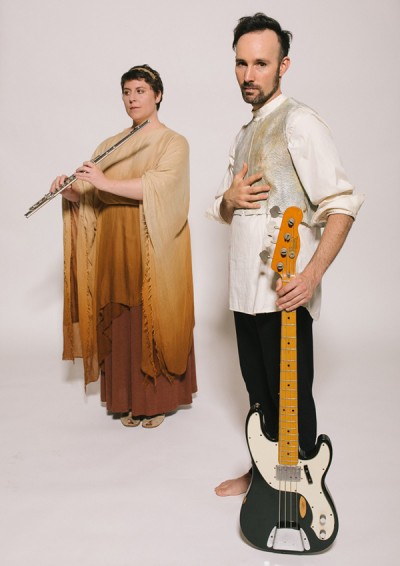 Elise Batchford and Holcombe Waller: Photo by Tyler Kalberg
Elise Batchford and Holcombe Waller: Photo by Tyler KalbergIn one of the less serious scenes, the music drops into a club tempo for a catwalk fashion number. Here the SacriFashion show, as it's dubbed, serves as an invocation of ancient ritual to determine the next among the passengers to die. It is death by fashion faux pas, where the characters take turns examining and trashing each others' costumes. The French horn’s over the shoulder short cape comes forward and is declared a castoff from Scotland Yard. The violinist is cheered for her nautical number, a striped jumper with sweet sailor buttons, christening her the “SS Molly.” Sadly, they pick the flute player for her umber toga hailing her with hilarious insults like, “It’s gettin’ biblical up in here.” Meanwhile on the sidelines, Waller is dressed like a Renaissance shaman in silver pants and a flouncy, ivory poet's blouse and vest.
It was certainly helpful to have a plot synopsis in the program as a preview, because once the stage darkened and the lights rose, the technological, psychological, mythological and navigational references come crashing in. Wayfinders sets you afloat in a deluge of music, image, poetry, humor, and incluing exposition to help you navigate the complicated world that Waller has created or, more accurately, that we have created and Waller is reflecting back at us. Like real life sometimes, it’s hard to know where to look with Wayfinders—at the humans on stage or the humans on screen. Real people or projections of people. And I think that’s the point of the multimedia exercise.
“I'm trying to come at it a bit sideways from a performance art approach, essentially,” Waller says. “I'm less concerned with musical ingenuity and more interested in unique meeting points of arrangement, writing, performance and design. The interplay between tempo and elements of the theater like video, sound and light.”
In that spirit, Wayfinders requires focused attention. This is not a spoon-fed Hollywood story. I would come to learn that Wayfinders is a complex play, complete with a space opera-style narrative summary in the program notes. Impossibly, I found myself wanting to see the libretto—more text or a script to follow along with—but to look down, even to take notes, would be to miss something. The overlapping speaking parts and artfully sung lyrics are so delightfully dense that I wanted to see it in a physical form in order to get my hands and head around it. I hoped for a new vinyl to paw over with jacket art to inspect and review, or a CD with all the lyrics and liner notes stuffed inside. I wanted a YouTube video on paused playback. I am aware of what I just said—I, like most, don’t believe what I am experiencing unless it’s documented in a way I can digest now and then later in private.
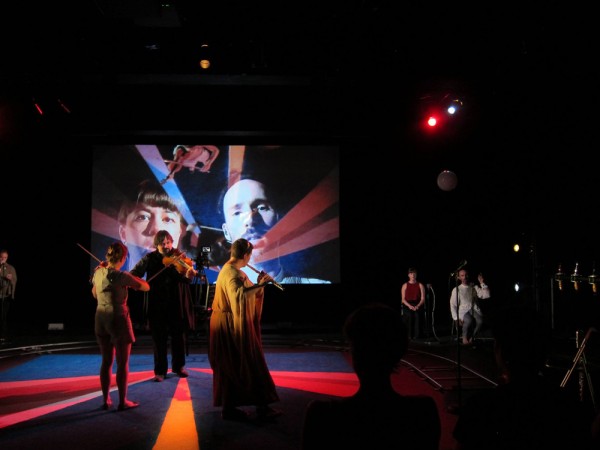 Wayfinders in Portland at the Imago Theatre on August 16.
Wayfinders in Portland at the Imago Theatre on August 16.Wayfinders is thoughtful and unexpectedly funny in places because the dark observations about human nature are true. The audience was awash in light, sound effects, six live musicians, and overlapping imagery from eight live cameras and multiple projectors. Despite all that massive input, they seemed to go happily along for the wild ride, laughing in recognition and unison at jokes about repetitive strain injuries (RSIs), carpal tunnel, how we give permission to upload our "most subtle mind," and how technology will “save” us.
Wayfinders also asserts that artificial intelligence is “evolving as yours devolved, unable to recall a 10-digit number” and we are “all strapped in, ready to go... in the romance of progress, in the romance of technology.” We unwittingly opt-in and engage with our computers and phones as they collect data from us. We have surveillance cameras around us and in our pockets all the time. Our GPS navigates us and yet we are still, in a sense, constantly lost.
Wayfinders feels in flux, a bit improvisational, like a “happening” or a sailing trip very much dependent on the weather, and there’s a reason for that. There’s a plasticity to the narrative as it travels. As we travel through it and react to it as audiences in different cities, those energies and feedback are incorporated into the script. It is a vehicle for investigating how technology can both illuminate and obscure the simple question: Where am I? Waller describes part of the focus as wanting to “convey the kind of ephemeral shift that we’re always going through in regards to technology, and the more true line of how orienting and navigating are so primally important to how we function as beings.”
As the voice of the autonavigator, or to use the archetypal figure of the trickster, Waller acts as our guide through the disorienting and reorienting process of Wayfinders. It is a physical, spiritual, navigational and relational meditation to witness and to immerse oneself in—and the opening text tells us so:
I’m like this endless transition, no beginning, no satisfying ending
forever addressing your ongoing needs
your whims are as complex as the weather - hey don’t worry, i got it
your dreams - huge, like oceans - but hey, no problem
you created me to catapult you into this illusion
to be the world you imagine you are seeing and hearing
and you’re not even sure any of it exists, well…
That’s the beautiful ambiguity we live in everyday, anchored to this world and lashed to technology. It is also the exploration that Wayfinders takes the audience through while the spaceship AI promises that the “immersion provides the richest sense of agency and autonomy within the staging area.”
“That’s my job,” Waller intones, “to keep you centered, stationary. Navigation is ancient. It doesn’t lurch you around, no. It keeps you still and lets the world move.”
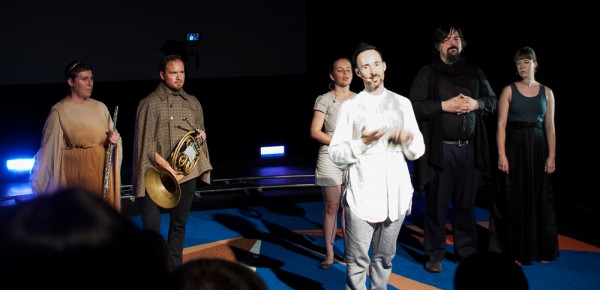 A gracious Waller and cast in Portland: Photo by Andrea Janda
A gracious Waller and cast in Portland: Photo by Andrea JandaIt will be interesting to see how the world of Wayfinders moves as it rolls on across the country. It will definitely be worth another visit to see if it ever arrives at a satisfying ending or if it is as mutable as the relationship we have with technology—at least as far out as we can imagine.

